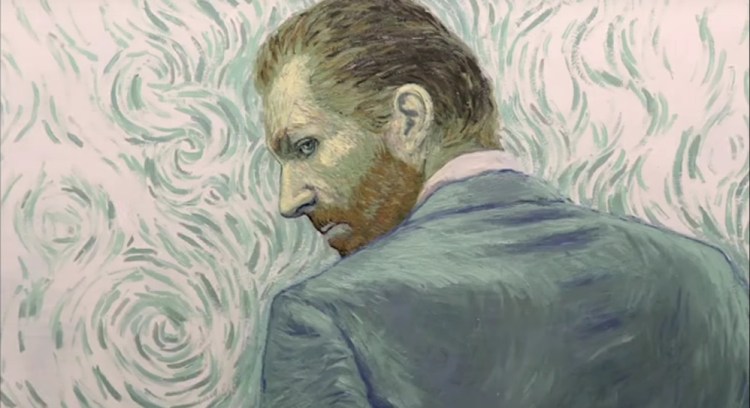Walking into “Loving Vincent” I was totally unprepared for what I saw, what I learned, what I felt.
Let’s get the wonderful details right out of the way: Dorota Kobiela and Hugh Welchman’s mind blowing animated portrait of the last days of Vincent Van Gogh employed the artistic services of 125 oil painting animators, who created 65,000 oil painted frames that inhaled 120 of Van Gogh’s 800 works, and after 10 years, spewed them out in all of their incredible colors. It’s like someone hit a giant piñata full of Van Gogh’s paints and spread them across the world. That is an act of love.
The surprise Polish-U.K. collaboration is an animated feature unlike any animation you’ve ever seen; there are no winking pandas or comic penguins, simply Vincent’s work come to life.
The world has long known Vincent’s sunflowers, but imagine watching them open and bloom, and people picking them.
The characters in the story amaze as they walk through the startling “Starry Night,” sit in “the Night Cafe,” and hundreds of Vincent’s other paintings come to life, moving as if we were there.
“Loving Vincent” demands to be watched on a truly big screen; this is not a film to be scanned on your iPhone; it’s breathtaking.
Each frame keeps evolving, bringing to life every figure, face, wheat field blowing in the wind, the famous black crows bursting out of the tall grass. That one alone will lift you out of your seat.
The big surprise is that “Loving Vincent” is no boring museum tour featuring the monochromatic drone of a docent leading us from airless room to room.
“Loving” is a first animated murder mystery.
Young Armand Roulin (Douglas Booth), a rootless 20-something arrives in the small town of Auvers-sur-oise where Vincent passed away, slowly bleeding to death from a bullet deep in his stomach.
Armand has come reluctantly on his postmaster (Chris O’Dowd) father’s orders to deliver a letter sent by Vincent to his beloved kid brother, art dealer Theo van Gogh, who died shortly after Vincent.
After asking questions in the town, Armand, lost in the peak of his youth, grows curious about the death of Vincent, and goes about seeking clues from Vincent’s last friends and neighbors: Adeline Ravoux (Eleanor Tomlinson) who liked the painter, and the mysterious Dr. Gachet (Jerome Flynn), Vincent’s doctor.
One clue leads to another. Arman walks the hot day streets, the cool forest of Vincent’s life, asking the questions: Why was he the way he was? Did he have enemies, did one of them lay in wait in his beloved fields and shoot him?
What would have been the motive? The paintings that covered his walls and lay stacked against the walls of his dusty rooms? They were of no value; he gave many away.
But two people begin to rise in interest, a wild boy who carried a gun and waved it about when it pleased him. The gun? Never found.
The other was the amateur painter Dr. Gachet, who copied some of Vincent’s work and longed to be as gifted.
Gachet’s daughter, Marguerite, is the love interest here, the painted face and voice of Saoirse Ronan raise the level even higher. Was she in love with the mad Vincent? The writers push that as far as it can go with any real facts buried in books and paintings hung in museums around the world.
The secret died with Vincent in a broken bed in a dark room with only brother Theo present. Theo’s secrets too, are posited.
“Loving Vincent” then is a long ago mystery with tantalizing answers painted in the maddening swirls of Vincent’s eyes, and in Clint Mansell’s score and Don McLean’s song “Starry Starry Night” wafting in the background.
J.P. Devine, of Waterville, is a for stage and film actor.
Send questions/comments to the editors.




Success. Please wait for the page to reload. If the page does not reload within 5 seconds, please refresh the page.
Enter your email and password to access comments.
Hi, to comment on stories you must . This profile is in addition to your subscription and website login.
Already have a commenting profile? .
Invalid username/password.
Please check your email to confirm and complete your registration.
Only subscribers are eligible to post comments. Please subscribe or login first for digital access. Here’s why.
Use the form below to reset your password. When you've submitted your account email, we will send an email with a reset code.